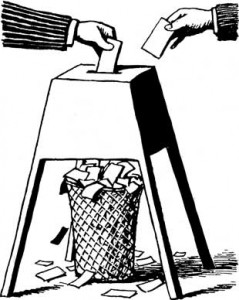The biggest disappointment of last Tuesday’s election, as I opined in an article by the San Antonio Express News, is that on Wednesday the national political landscape still looked a lot like it did on Monday.
I tried to write this week’s column about business lessons from election marketing, but it was weak and didn’t say anything that hasn’t been said a million times already. I need to take this space to discuss what happened, and what has to happen next.
I feel that the American people spoke clearly. The fact that it seems to be a mixed message is due to an inability by the decisive swing voter, the 40% who identify themselves as independent, to enunciate anything that can be heard above the din of the warring factions.
We reelected a President who seeks new taxes and an expansionist role for government, while simultaneously giving him a House of Representatives (which originates all spending decisions), that is opposed to both. Even more revealing, however, were the results of the elections for statewide offices; those for Senator and Governor.
The Democrats took every Senate election that was even remotely in reach. At the same time, the Republicans seated an all-time record number of Governors. Indiana voted for Romney, and sent a Democrat to the Senate. Wisconsin also chose a Democrat for Senate and committed their electors to President Obama, while Republicans simultaneously swept both houses of that state’s legislature. What’s going on?
 At the almost certain risk of scathing remarks from the true believers on either side, I think both parties failed to convince the plurality of voters in the middle that they could follow sensible paths, that they would be willing to move to the middle to get things accomplished.
At the almost certain risk of scathing remarks from the true believers on either side, I think both parties failed to convince the plurality of voters in the middle that they could follow sensible paths, that they would be willing to move to the middle to get things accomplished.
The problem is plain. For almost a century, the United States Congress had a balance, regardless of which party was in power. If the Democrats wanted to expand social programs, they needed the assistance of moderate Republicans from New England, the Middle Atlantic and the Great Lakes (blue states). Those Republicans would say “I like the idea, but we have to be careful about the spending. Scale it back a bit and I can support you.”
Similarly, when Republicans wanted stronger defense or looser market regulations, they had to approach conservative southern Democrats. Those “red state” Dems would say “OK, but not enough to let Wall Street or the generals run amok. Let’s keep some oversight in place here.” The laws that came out weren’t so much compromises as they were the agenda of the party in power, tempered by the others they needed to get it through.
Over the last 15 years, both parties have purged those “moderate” members from their ranks. The socially liberal Republican has gone to the boneyard to lie down next to the fiscally conservative Democrat. To make up for those lost votes, the parties have wielded their fundraising muscle to force 100% adherence to the party line, making razor-thin majorities into a bloc on every issue.
I’ve collected multiple stories about threats and ostracization on both sides against those representatives who dare to vote the party line only 96% or 98% of the time. Younger representatives say frankly that they don’t know members of the other party well, and that even conversation with them is discouraged.
Thomas Jefferson was adamantly against political parties. He said that if parties became powerful, then inevitably elected officials would owe allegiance to their party over the country. The parties today, with their ability to direct the billions of dollars needed for television advertising, are more powerful than ever before. Thomas Jefferson’s fear has come to pass.
The 40% of Americans who don’t buy into either party’s platform entirely are desperately trying to find a solution using the only tool they have, a split ticket at the ballot box. We can only hope that some courageous statesmen and stateswomen respond.

2 Responses to An Independent Look at the Election